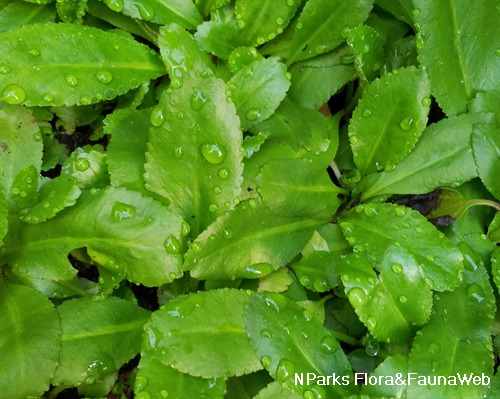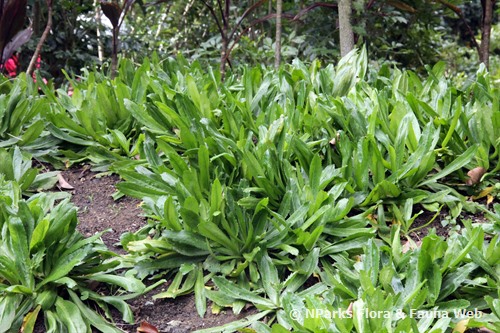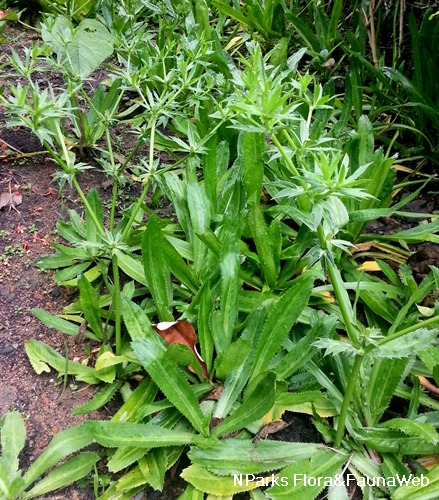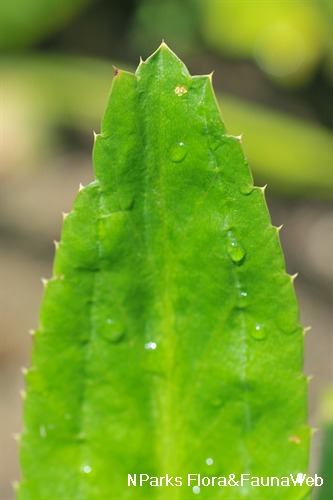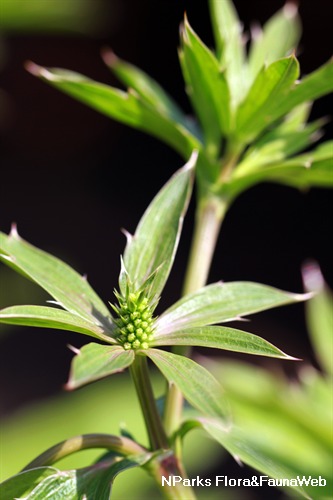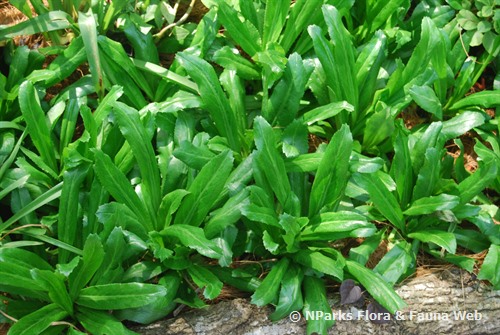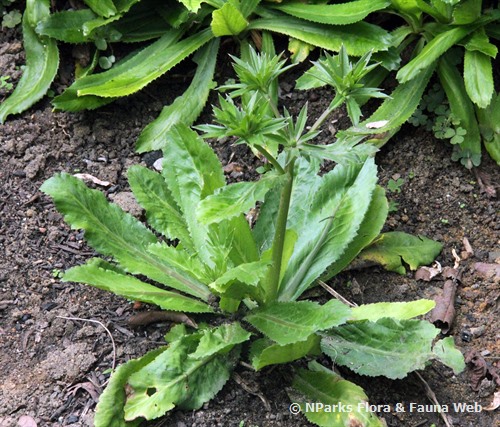
Back
Eryngium foetidum L.
| Family Name: | Apiaceae (Umbelliferae) |
| Synonyms: | Eryngium antihystericum |
| Common Name: | Sawtooth Coriander, Vietnamese Coriander, False Coriander, Spiny Coriander, Serrated Coriander, Thorny Coriander, Long Coriander, Stinkweed, Spiritweed, Fitweed, 刺芹, 刺芫荽, 洋芫荽, 美国刺芫荽 |
Name
Classifications and Characteristics
| Plant Division | Angiosperms (Flowering Seed Plants) (Dicotyledon) |
|---|---|
| Plant Growth Form | Herbaceous Plant |
| Lifespan (in Singapore) | Biennial |
| Mode of Nutrition | Autotrophic |
| Maximum Height | 0.2 m to 0.5 m |
| Maximum Plant Spread / Crown Width | 0.4 m to 0.6 m |
Biogeography
| Native Distribution | Mexico, Central America, Caribbean Islands, South America |
|---|---|
| Native Habitat | Terrestrial (Disturbed Area / Open Ground) |
| Preferred Climate Zone | Sub-Tropical / Monsoonal |
Description and Ethnobotany
| Growth Form | Biennial or perennial, self-seeding herb. Tends to be perennial in Southeast Asia. |
|---|---|
| Foliage | Leaves green, glabrous and oblanceolate (13 - 30 cm long, 3 - 4 cm wide). Leaves are arranged in a basal rosette. Leaf margin is serrulate (finely toothed). |
| Flowers | Creamy white flowers are arranged in a reduced umbel inflorescence that is cylindrical with a dome-shaped top (1.2 cm long, 0.5 cm wide). Flowers continuously throughout the year in Southeast Asia. |
| Fruit | Fruits are egg-shaped schizocarps (1.5 mm long) that are covered by round bumps. |
| Habitat | Occurs in forests or land that have been cleared by slash and burn practices. Also found near trails that are shaded where soil is moist. Found at altitudes from 0 – 1700 m. |
| Cultivation | Sawtooth Coriander (Eryngium foetidum) is better adapted to Singapore's climate than Coriander (Coriandrum sativum) which tends to flower too early. Plant Sawtooth Coriander in well-drained sandy loam soils that are rich in organic matter. In general, this plant is hardy and resistant to most pests and diseases. In a study based in Massachusetts (USA), optimal growth for harvesting occurred at 40% shade and ≥ 90 kg N / ha fertilization (Casey et al 2004). These conditions maximized the leaf area ratio (combined leaf area per total plant mass). This species grows best in full sun, but it tolerates semi-shade which delays flowering. Leaves become tougher and less juicy after flowering, reducing their palatability. For home gardens, use a slow-release fertilizer (NPK: 14-14-14) at a concentration of 1.8 kg / m3. Propagate by seed or division. |
| Etymology | The genus name “Eryngium” is derived from “eryngion,” the Greek name of the sea holly (Eryngium maritimum). The species epithet “foetidum” is Latin for a bad smell. The leaves produce an odor that has been described like that of a squashed bedbug. |
| Ethnobotanical Uses | Edible Plant Parts : Edible Leaves Food (Herb or Spice): The leaves are rich in calcium, iron, carotene and riboflavin. In Thailand, Vietnam, Laos and India, the leaves are used fresh as a culinary herb which has a similar, but stronger flavor than Coriander (Coriandrum sativum).The leaves are used to season meat and other foods in Caribbean, Latin American and Asian cuisines. It is often added to chutneys, a sauce containing fruits or vegetables that is eaten with other dishes. In Latin America, the leaves are often added to salsas, a spicy, tomato-based sauce that is eaten with tortilla chips. Medicinal: Tea prepared from the leaves is used to treat fever, flu, diarrhoea, constipation, and vomiting. It is also thought to promote menstrual bleeding. The roots are consumed raw as a treatment for scorpion stings. Others: In Java, the plant is fed to cattle as fodder. |
Landscaping Features
| Landscaping | Planted in herb gardens or containers. |
|---|---|
| Desirable Plant Features | Fragrant (Foliage) |
| Landscape Uses | Container Planting, Parks & Gardens, Small Gardens |
| Thematic Landscaping | Economic Garden |
| Usage Hazard - Cons | Spines/Thorns - Leaf |
| Usage Hazard - Cons Remarks | Caution: Leaf edges and tips may be sharp, especially those of leaves on the floral stalk. |
| Plant & Rootzone Preference or Tolerance Remarks | Sandy loam |
Plant Care and Propagation
| Light Preference | Semi-Shade, Full Sun |
|---|---|
| Water Preference | Moderate Water |
| Plant Growth Rate | Fast to Moderate |
| Rootzone Tolerance | Fertile Loamy Soils, Well-Drained Soils, Disease / Pest Resistant |
| Maintenance Requirements | Moderate |
| Diseases | Attacked by the cicadellid leafhopper (Agallia lingula) and garden fleahopper (Halticus bractatus) |
| Pest(s) | Associated with, Chewing Insects |
| Propagation Method | Seed, Division |
Foliar
| Mature Foliage Colour(s) | Green |
|---|---|
| Mature Foliage Texture(s) | Smooth |
| Prominent Young Flush Colour(s) | Green |
| Young Flush Texture(s) | Smooth |
| Foliar Type | Simple / Unifoliate |
| Foliar Arrangement Along Stem | Rosulate / Rosette |
| Foliar Attachment to Stem | Sessile |
| Foliar Shape(s) | Non-Palm Foliage (Oblanceolate) |
| Foliar Venation | Pinnate / Net |
| Foliar Margin | Serrate / Toothed |
| Foliar Apex - Tip | Acute |
| Foliar Base | Cuneate |
| Typical Foliar Area | Mesophyll ( 45cm2 - 182.25 cm2 ) |
Non - Foliar and Storage
| Stem Type & Modification | Acaulescent |
|---|---|
| Root Type | Underground (Tap Root) |
Floral (Angiosperm)
| Flower & Plant Sexuality | Bisexual Flowers |
| Flower Colour(s) | Cream / Off-White, White, Yellow / Golden |
|---|---|
| Flower Symmetry | Radial |
| Flower Size - Remarks | 1.2 cm long. 0.5 cm wide |
| Inflorescence Type | Umbel |
| Flowering Period | Free-Flowering |
Fruit, Seed and Spore
| Fruit Classification | Simple Fruit |
|---|---|
| Fruit Type | Indehiscent Dry Fruit , Schizocarp |
Image Repository
Others
| Master ID | 30541 |
|---|---|
| Species ID | 4850 |
| Flora Disclaimer | The information in this website has been compiled from reliable sources, such as reference works on medicinal plants. It is not a substitute for medical advice or treatment and NParks does not purport to provide any medical advice. Readers should always consult his/her physician before using or consuming a plant for medicinal purposes. |

